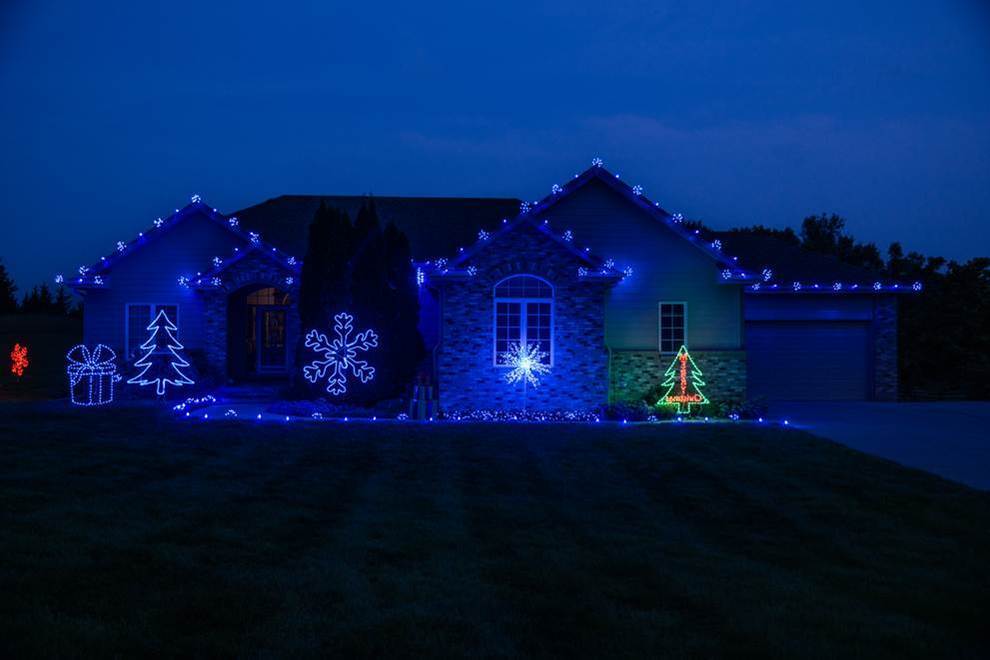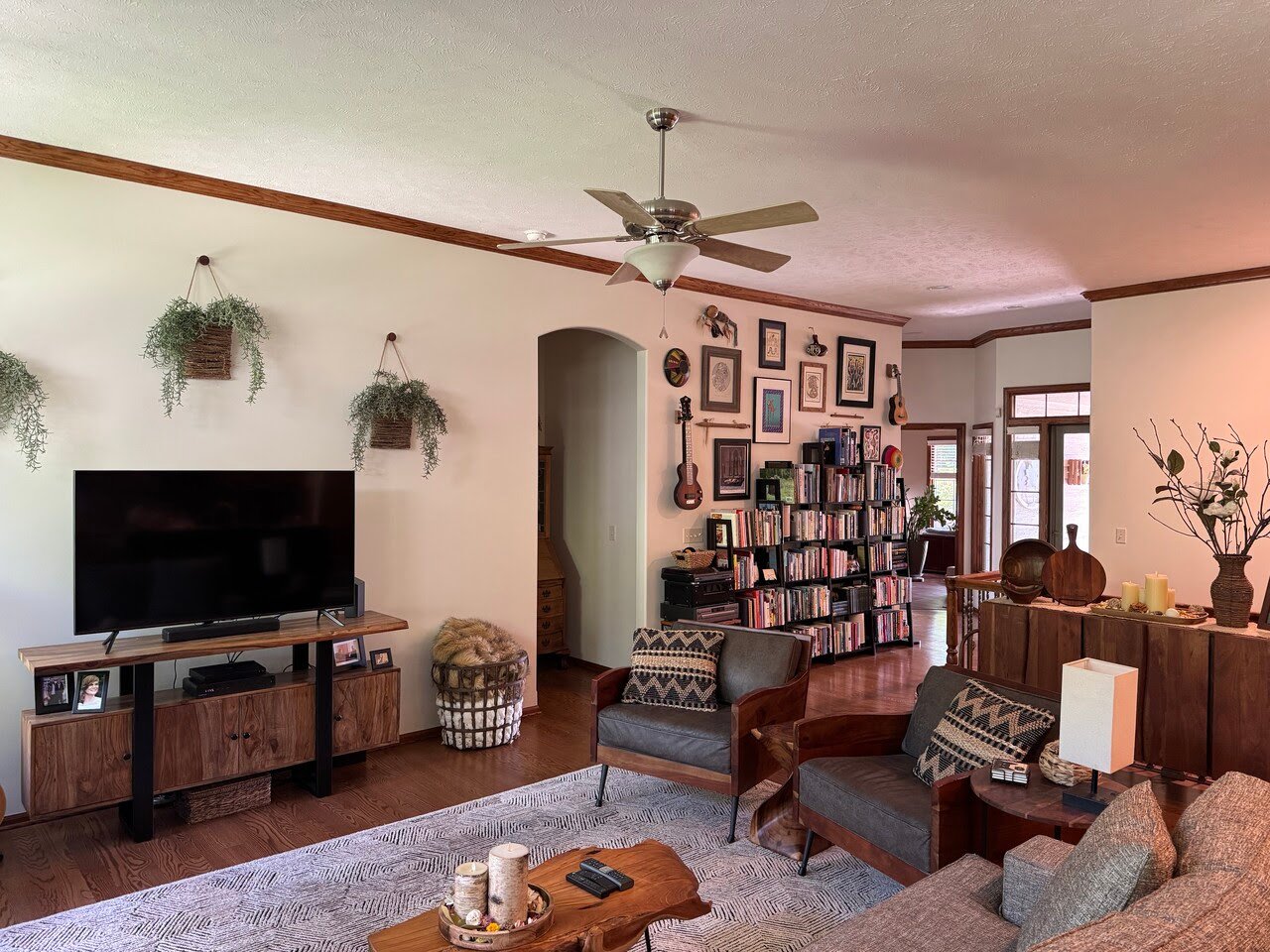Should You Paint All Rooms In Your Home the Same Color?
August 6th, 2025
5 min read
-1.jpg?width=1280&height=721&name=Havens%20after%204%20(1)-1.jpg)
You’re standing in your hallway, looking from one room to the next, and wondering if it’s okay that your kitchen is sage green, your living room is warm beige, and your office is leaning toward navy. You want each space to have its own look, but you’re also trying not to make your home feel like a patchwork of disconnected ideas. You’re not alone in this. Many Omaha homeowners want their homes to feel personal, expressive, and inviting, but the idea of painting every room a different color brings up some hesitation.
At Brush & Roll Painting, we’ve helped hundreds of homeowners across the Omaha area since 1996. We’ve seen homes that look stunning with different colors in every room, and others where a consistent palette makes everything feel larger and calmer. We’ve painted small hallways, open concept living spaces, kids’ rooms with bold pops of color, and everything in between. We know what works, what doesn’t, and most importantly, how to help you feel confident in your choices. We also understand that this is your home, and your paint colors should work for your style, not the other way around.
This article is here to help you decide whether each room in your home should have its own paint color or if a more consistent palette is the way to go. We’ll walk through the benefits and drawbacks of both approaches. You’ll also learn what types of layouts, lighting, and home styles affect how colors work together, and how to strike the right balance between personality and cohesion. By the end, you’ll have a better sense of how to plan your home’s colors in a way that feels just right for you.
Painting Each Room a Different Color
A lot of homeowners feel drawn to this idea, especially when they want to give each space its own vibe or function. Here’s what makes it appealing and what to watch out for.
Pros of Using Different Colors in Each Room
- Personal expression: Maybe your daughter wants a soft pink bedroom, you want your home office to feel energizing in a deep blue, and the kitchen feels best in a warm creamy white. With different shades, you can give each room its own mood.
- Function-based design: If one room is for relaxing and another is for working, it makes sense to use color to match the function. For example, cool tones can feel calming in a bedroom, while warmer or more saturated colors can help boost focus in a workspace.
- Play with light: Some rooms may have lots of natural light, while others feel darker. Using different colors lets you adjust each space to look its best.
- Create surprise: There’s something fun about walking into a room that feels totally different than the last. It keeps things interesting and makes the home feel more curated.

Cons of Using Different Colors in Each Room
- Lack of flow: If every room has a completely different color, it can feel a bit jarring, especially in smaller homes where you can see multiple rooms at once. This is a common concern for homeowners in Omaha’s mid-size and older homes with tighter layouts.
- Color fatigue: Bold colors can be fun, but having too many contrasting ones in a row can start to feel overwhelming. It can make your home feel smaller or disjointed.
- Harder resale: While you should absolutely choose colors you love, keep in mind that homes with wildly different colors in every room can be harder to stage or sell if the next buyer prefers a more neutral palette.
- Tricky transitions: If you’re not careful, you might end up with colors that clash where rooms connect — like hallways, door frames, or open-concept areas. This is especially important in homes where sightlines from one room to another are open.

When Keeping the Same Paint Color in Each Room Works Better
There’s a reason why so many homes in Omaha stick to just one or two main colors. It’s not just because it’s easier; it can also make a home feel larger, cleaner, and more peaceful.
Pros of Using a Consistent Color Palette
- Makes the home feel bigger: When you use the same or similar colors throughout, it tricks the eye into seeing the space as more open. This works especially well in ranch homes or homes with open floor plans.
- Smoother transitions: If you have hallways, arched openings, or sightlines into multiple rooms at once, repeating the same wall color avoids visual conflict.
- Simplifies decorating: When you keep your walls consistent, it gives you more flexibility with furniture, art, and decor. You won’t feel limited by needing every pillow or curtain to match different walls.
- Easier touch-ups and repainting: Let’s face it, repainting a whole home is an investment. Using the same color in multiple rooms means less paint waste, simpler maintenance, and easier fixes over time.
Cons of Using a Consistent Color Palette
- It can feel too plain: If everything is the same color, you may miss the feeling of personality in each space. That’s especially true if you’re a person who enjoys creativity and uniqueness.
- Less mood control: Some colors are better suited for relaxing, others for working, and others for energizing. Using one color everywhere may not support those goals as well as tailoring colors room by room.

How to Combine Both Approaches the Right Way
Here’s the good news: you don’t have to choose one extreme or the other. Many Omaha homeowners find the sweet spot by using a blend of both ideas. Here’s how:
1. Start with a Neutral Base Color
Pick one soft, neutral color that you love, something that works in your main spaces like the living room, hallways, or kitchen. This becomes the anchor. Popular choices in Omaha right now include warm whites, greige, and soft tans.
2. Add Accent Colors in Smaller Rooms
Use color to create moments of personality in bedrooms, offices, bathrooms, or mudrooms. These are great places to add deeper tones or something unexpected without throwing off the whole house.
3. Stick Within a Cohesive Color Family
Even if you change up colors, try to stay in a similar temperature (warm or cool) or saturation level. For example, you can use different earthy tones throughout your home, and it will still feel connected.
4. Use Transitions to Your Advantage
Trim, doorways, or accent walls can help ease the transition between rooms with different colors. At Brush & Roll Painting, we often see homeowners in older Omaha homes use white or off-white trim to give separation between bolder wall shades.
5. Think About Lighting
The same color can look different depending on the lighting in each room. Natural light, light bulbs, and ceiling height all affect how paint looks. If a color doesn’t look quite right in one space, adjusting just the tone or finish can make it work better.
Interior Painting in Omaha, NE
Choosing whether to paint each room a different color or keep it consistent really comes down to what feels best for your space and your style. Some homeowners want a peaceful, connected look with light tones throughout. Others want their home to reflect each person in the family, with colors that match the mood and purpose of every room.
This article gave you the pros and cons of each option and helped you think through the layout of your home, your goals, and how to strike the right balance. You don’t have to commit to one approach for the entire house. In fact, most homeowners land somewhere in the middle, and that’s where the magic usually happens.
At Brush & Roll Painting, we’ve helped Omaha homeowners choose colors that feel personal, flow beautifully, and stand the test of time. If you’re getting ready to paint and are not sure how to plan your colors, we’d be happy to help.
Click the button below to get a quote for your next project.
And if you're still deciding on colors, download our free color and design guide. It includes 7 tips that will help you choose the best paint colors for your home, whether you go bold, stay neutral, or mix a little of both.
Kaylea is the Brush & Roll Painting Content Manager. Kaylea is a Journalism and Media Communications summa cum laude graduate with a minor in Marketing from the University of Nebraska at Omaha. Kaylea manages the marketing for Brush & Roll Painting.
Topics:
















-Jul-23-2025-02-21-33-5468-PM.png?width=800&height=418&name=Blog%20Post%20Image%20Size%20(2)-Jul-23-2025-02-21-33-5468-PM.png)




-Oct-22-2025-01-39-19-5208-PM.png?width=800&height=418&name=Blog%20Post%20Image%20Size%20(1)-Oct-22-2025-01-39-19-5208-PM.png)





